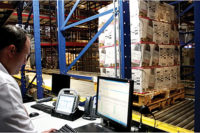New and updated software suites available today help snack and bakery companies efficiently manage any supply-chain or finished-product traffic traveling in and out of the warehouse. Companies benefit from this software because their facilities always have what they need for production runs on hand at any given time—there’s no lag in ingredient ordering.
Highlighted features
“Many companies have core business systems, or enterprise resource planning/ERP systems, that do a good job for financial tracking,” says Dustin Caudell, vice president of sales, RFgen Software, El Dorado Hills, CA. But in the warehouse, he continues, these systems often require manual data entry for tasks like purchase order (PO) receiving, inventory movement, tracking lot numbers, picking, ship confirmations, inventory adjustments, counts, etc. “When we add RFgen, it helps them automate these business functions.”
Caudell notes that relying on manual documentation of incoming items, quantities and inventory lots, as well as movement in, out and around the warehouse, can cause problems. This can include delayed data entry, with the ERP system showing data that’s one or two days out of date compared to actual inventory, as well as inadvertent transposing of numbers when writing things down or typing things into the computer and potentially picking and shipping the wrong product to a customer.
“Inventory is barcoded, movements are scanned using barcoding and a mobile computer, and RFgen updates the customers’ ERP/business system in real time,” says Caudell. “Then they know exactly what they have and where it is at any given time. The scanning and barcoding eliminates data entry mistakes.”
CLIF Bar recently started using the RFgen Mobile Foundations for Oracle’s JD Edwards EnterpriseOne. This lets bakery associates use wireless barcode scanners.
UNEX, Lakewood, NJ, has SKU slotting software, called SKUBE, which analyzes the movement of inventory and maps that movement to a warehouse design, says Brian C. Neuwirth, vice president of sales and marketing.
“SKUBE slotting software evaluates your specific operation and will provide you with a custom, 3D AutoCAD model of your warehouse,” explains Neuwirth. “SKUBE can help you prioritize and optimize your operation’s throughput and allow you to strategically slot your SKUs to the proper storage medium.”
SKUBE can help place high-velocity SKUs in areas where they can most efficiently be accessed, picked, packed and shipped. This helps personnel optimize traffic in and out of the warehouse by ensuring the SKUs generating the most traffic are stored in the most efficient position possible, says Neuwirth. This helps users avoid operational or structural bottlenecks, he notes.
FlexiBake, Vancouver, British Columbia, offers a comprehensive warehouse software suite. “FlexiBake’s warehousing module allows inventory to be purchased, delivered and transferred between your various production facilities and remote warehouse locations,” says Nicole Ortner, senior account executive. “Using FlexiBake, raw material and finished product movement can be easily tracked between locations and through the production process.”
Ortner says that virtual replicas of the warehouse layout are customizable in FlexiBake, with palletizing tools allowing pallets to be designed and easily located when it comes time to ship an order.
EVS, Boulder, CO, recently introduced a cloud-based warehouse management system (WMS). “EVS’s iOS-native mobe3 Cloud WMS has re-thought the warehouse management experience,” says Evan Garber, CEO.
mobe3 is a WMS platform that integrates enterprise applications (ERP, TMS, LMS, etc.), as well as models operations with flexible rules for put-away, picking/packing/shipping, directing employees to do the right actions at the right time, and measuring operational performance with comprehensive dashboards to facilitate continuous improvement, says Garber. “As the industry continues to trend toward e-commerce fulfillment and omnichannel distribution, mobe3 WMS warehouse optimization can help manufacturers make ‘each pick’ fulfillment profitable.”
Predictive ordering
“Predictive ordering is generally part of an ERP suite, and that would rely on solid real-time inventory data,” says Caudell. “RFgen provides solid real-time inventory data.”
Caudell says that most of their customers do forecasting and ordering in their ERPs like SAP, Oracle and JDE, but rely on RFgen to keep the inventory up to date in real-time in the warehouse.
“In the food industry, using RFgen also helps the customer with complete traceability,” says Caudell. This includes digital recordkeeping connecting lot numbers to products and specific orders. “If there is a recall, we can identify every problem item in the warehouse by lot number, and we can also quickly identify if that lot number has been shipped to a customer, when it was shipped, etc.,” he explains.
FlexiBake forecasts production based on historical values, which can be used to automatically create POs for raw material requirements, which are then ready to send to suppliers, says Ortner. “Purchasing tools like bill of materials, minimum stock levels and ordering alerts make purchasing through FlexiBake simple and efficient.”
Neuwirth explains that sensors can connect to all equipment throughout the warehouse, and these sensors generate data that can be collected in real-time. “Having access to real-time customer demand pattern data helps managers match inventory and inventory levels to customer orders accurately, helping to increase customer satisfaction,” he explains.
“Data can be analyzed to predict seasonal trends, spikes or reductions in customer demand to ensure the right levels of inventory are available at the right locations. With more-accurate predictions, proper levels of inventory can be stored in carton flow racks and shelving,” comments Neuwirth.
Garber says that although predictive ordering isn’t a function of WMS, real-time, accurate inventory is a key component. “By capturing shop floor data, whether from scales, PLCs, other industrial equipment or from people handling inventory, mobe3 WMS provides live and accurate inventory levels to your ERP solution.”
Multitasking technologies
One of UNEX’s newest pieces of equipment for bakery and snack food distributors is the highly configurable UNEX Roller Rack, which is available with a variety of carton flow beds, such as the roller lane, which ensures smooth carton flow, says Neuwirth. “Many snack food and bakery distributors and warehouses don’t use automated equipment in their order picking and fulfillment processes because the automated equipment can easily damage snack food and bakery items. Ensuring products efficiently reach customers at the right time and place in the best quality ensures repeat business.”
The Roller Rack ensures smooth carton flow, keeping products at the pick point for workers, and has a pallet track that features a spring-loaded rear stop that prevents pallets from accidentally being pushed back and falling off the rack.
With any food-related product, expiration dates are a major concern, says Neuwirth. Products must be picked before a product expires. UNEX Carton flow order picking systems make picking the first-in, first-out (FIFO) method easier by ensuring that the first products into the storage unit are the first products to be picked to fill an order.
“Using FIFO racks means food products will be used within the correct date range. FIFO will keep products up to date and avoid spoilage, which can cut into bottom lines,” says Neuwirth. He notes that these systems can be combined with automated voice picking, pick-to-light and similar systems to speed fulfillment.
“When needed, our software will recommend lots based on FIFO,” says Marc Braun, president, Pcdata Inc., East Granby, CT. “Our inventory manager module supports the process of receiving goods into the warehouse: registration, tagging and allocation of the goods based on predefined locations are dynamically addressed.”
Pcdata’s Distrib suite of software is running in hundreds of bakery warehouse operations in the U.S., adds Braun. “It helps the order-fulfillment process by making it more accurate and faster than picking on paper can be.”
EVS’s mobe3 system provides warehouse modeling to test whether current operating methods are optimum, says Garber. “As business changes, your organization needs to change with it. mobe3 tests if your warehouse staffing is right for the near future requirements, and/or how a new distribution center would affect your throughput.”
FlexiBake can manage the warehouse as a secondary production facility, says Ortner. “You can set up production schedules for multiple facilities, ship to and from different warehouse locations, and transfer inventory between the locations—all done in FlexiBake with less than 20 minutes of setup,” she explains.
















